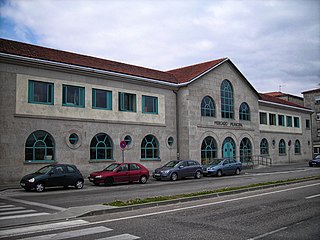
Pontevedra is a city in the autonomous community of Galicia, in northwestern Spain. It is the capital of both the Comarca and Province of Pontevedra, and the capital of the Rías Baixas. It is also the capital of its own municipality which is often considered an extension of the actual city.

The church of the Pilgrim Virgin is a scallop-shaped Roman Catholic chapel located in the city of Pontevedra, in Spain, along the route of the Portuguese Way of St. James.

The Burgo Bridge(Puente del Burgo) is a medieval bridge, built over an older bridge of Roman origin, which crosses the Lérez River in the city of Pontevedra, Spain. It is on the route of the Portuguese Way to the north of the historic centre of Pontevedra and to the south of the Burgo neighbourhood. Between the arches above the pillars are carved the famous stone pilgrim's shells.

The Covo Island, better known as the Island of Sculptures or Illa das Esculturas in Galician, is a park and island located near the mouth of the Lérez River, in Pontevedra, Spain. It has an area of 70,000 m² and is connected to both banks of the river by footbridges and pedestrian bridges. It is the largest and most important open-air museum in Galicia and one of the most important in Spain.

The Palace of the Deputation of Pontevedra, in Pontevedra, Spain, is the seat of the Provincial Deputation of Pontevedra, the provincial government of the province of Pontevedra. It is located between the Alameda de Pontevedra and the Palm Trees Park.

The Pontevedra Auditorium and Convention Centre is a building that hosts conventions, exhibitions, concerts, plays and ballet and dance performances in Pontevedra (Spain). It is located in the northern part of the city, next to the Lérez river and the Tirantes bridge and was designed by the architect Manuel de las Casas.

The Lérez beach is a Galician beach located in the municipality of Pontevedra in the province of Pontevedra, Spain. It is a semi-urban river beach with a length of 100 metres.

The Ria de Pontevedra is located in the Province of Pontevedra, in Galicia, Spain. It is one of the three main maritime entrances of Galicia, the Rías Baixas, the most touristic area of the region. It is also the most regular of them and the third largest of all those in Galicia with a surface area of 145 km2 (56 sq mi).

Monte Porreiro is a residential area in the city of Pontevedra (Spain). It is the seat of the National University of Distance Education in the province of Pontevedra. The neighbourhood has a health centre, a school and a high school and a parish church since the end of the 20th century, its patron saint being the Good Shepherd. There are also green areas, the most important being the Belvedere Park.

The Tambo Island is an island in the middle of the Pontevedra bay, in Spain. It belongs to the municipality of Poio, from which it is separated by a 1.1 km long but shallow channel. Its surface area is 0.28 km2, with a maximum height of 80 m, although its entire central part is over 50 metres high. Its perimeter reaches 4 km.

The Palace of Lourizán is a manor house in Herbalonga in the civil parish of Lourizán, in Pontevedra, Spain.

The Botanical Garden of Lourizán is an arboretum of some 54 hectares in the municipality of Pontevedra in Spain. It has more than 850 catalogued species and one of the largest collections in Spain. It is the most important botanical garden in Galicia.

The Central Market of Pontevedra is a covered market located in Pontevedra, Spain. It is located at the north-eastern edge of the historic centre, close to the Burgo Bridge. It overlooks the banks of the Lérez river and was inaugurated in 1948.

The Gobierno Civil de Pontevedra, currently Subdelegación del Gobierno de Pontevedra, is an official building located in Pontevedra, Galicia (Spain). It has served since its construction as the government delegation office representing the Spanish state in the province of Pontevedra.

Méndez Núñez Square is a square of medieval origin located in the heart of the historic centre of Pontevedra (Spain).

The historic centre of Pontevedra (Spain) is the oldest part of the city. It is the second most important old town in Galicia after Santiago de Compostela, and was declared a historic-artistic complex on 23 February 1951.

The Convent of St. Francis is a Franciscan convent located in the city centre of Pontevedra (Spain), overlooking the Plaza de la Herrería. The Gothic church of San Francis is attached to the convent on the southeast side.

The Plaza de la Peregrina is an 18th-century square located in the city centre of Pontevedra (Spain), on the edge of the historic centre.

Curros Enríquez Square is a square of medieval origin located in the heart of the historic centre of Pontevedra (Spain), on the Portuguese pilgrimage way.

St. Joseph's Square is a 19th century square located in the centre of the city of Pontevedra (Spain), in the first urban expansion area, near the Campolongo neighbourhood.































